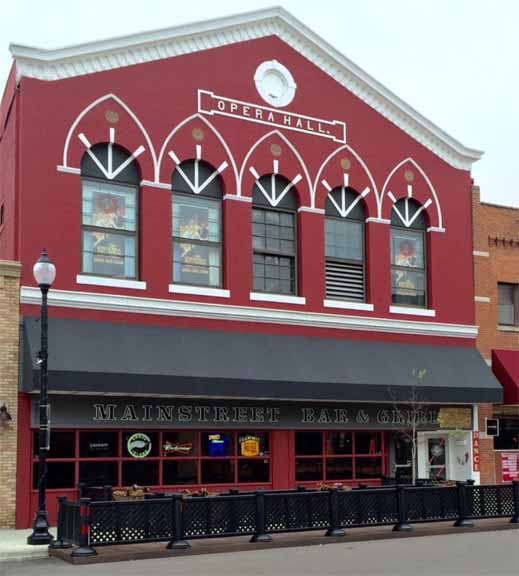Bull Pen
The Bull Pen was one of the best-remembered venues in Hopkins’ Opera Hall, located at 814-16 Mainstreet, Hopkins. The original address was Excelsior Ave., before the realignment of Excelsior Ave. when Highway 169 came through.
This page will cover the various entertainment venues that have come and gone in the building, including:
- The Opera Hall, aka Olson’s Hall
- (Sheehan’s) 908 Club
- The Bull Pen
- The Opera Hall Saloon
- The Mainstreet Bar and Grill
The building had two storefronts, East and West, and a large hall on the second floor that was rented out for events. The hall was used extensively by the community, as it was the largest in Hopkins.
OPERA HALL
There is some conflicting information about the origins of the building. The county’s tax database says that it was built in 1900, and there is plenty of evidence that it was once known as Olson’s Hall. This leads me to believe that it was built, or at least financed, by Hilmer Olson. [There was another, older, Olson’s Hall, located at 1209 Washington Ave. So. in Minneapolis, that went back to at least 1880.]
HILMER OLSON
Olson was a wealthy farmer, and for 22 years he was a banker at the First National Bank of Hopkins. He was born in about 1863, and in 1931 he lived at 904 1/2 Excelsior Ave. In August 1939 he and his wife were in a car/truck accident – he was driving the car. His wife, age 63, died as a result of her injuries. He remarried before his death in August 1946 at the age of 83.
OTHER NAMES
Nothing comes up under Olson Opera Hall; there were only a couple of hits under Hopkins Opera Hall. It was mostly called Olson’s Hall from 1900 to 1940.
ALBERT F. ANDERSON?
But an article in the Star and Tribune, apparently based on information from the Hopkins Historical Society, dates the building to 1904 or 1904, and says it was built by Albert F. Anderson. A search through the Strib archives reveals that Anderson applied for a liquor license for both storefronts in the building on block 4, lot 1, for the period between April 1, 1898, and March 31, 1899. He made the same request for the time period from April 1, 1899 to March 31, 1900, but this time only for the West Room. He is mentioned in 1905 when a bartender accused Anderson of giving him a beating for being late in opening his saloon.
Problems include the fact that the Hall sits on Block 4, Lot 3 – Lot 1 is on the western corner of the block. That building is listed as being built in 1902 in the County’s database. Perhaps more research is needed in the Hopkins papers.
ACTIVITIES IN THE HALL
The Opera Hall was used for dances and recitals, sponsored by different groups. The first activity we see in the Strib archives at the Olson Opera Hall is in September 1902, which is a political meeting.
THE ODD FELLOWS PARTY
Shortly after that, in 1903, was a rip-roaring Odd Fellows Carnival – actually the overflow from the new IOOF Temple that was across the street. The carnival went on for days, with each day sponsored by a different Lodge of Odd Fellows from Minneapolis. On September 29, 1903, for example, the North Star lodge descended on Hopkins, “accompanied by Coon’s orchestra.” Members entertained the crowd with routines “in the arts of black-face minstrelsy.” One man’s monologue on milk sent the audience into “paroxysms of laughter.” Coon songs, routines in black face, and minstrel shows were still much in vogue in 1903. The Odd Fellows from Minneapolis might have actually seen a black person; although the City was very segregated, the few black men and women living in town could generally find employment as Pullman porters, hotels workers, and other low-level jobs. Whether people living in Hopkins had ever seen black people is something to wonder.
The following night was sponsored by the Flour City Lodge, with decidedly more sedate entertainment featuring a Masonic quartet, violinists, a “facial and musical artist,” and a humorist and impersonator who “will make fun.” Despite these hilarious hijinks, there was no rowdyism, and “no trouble, no fakirs, no grafters,” reported the Deputy Marshall.
Thursday was Ladies’ Night, presented by 25 of the ladies of the Iola Rebekah Lodge No. 35, who tended to be “more or less literary and musical, with vocal and instrumental solos, recitations, tableaux, etc.” Sounds like those ladies in the “Music Man:” “Ode to a Grecian Urn.”
And this:
One of the most unique exhibits seen at the carnival is a monster cigar manufactured by J.Y. Kern of Hopkins. The immense “smoke” is eight feet in length, eight inches in diameter and weighs twenty-five pounds. It is named “The Dr. Moore Cigar,” in honor of a local physician.
May 1906: Sorenson and Wallace Bakery (Hopkins News, per HHS)
In 1909, wrestling was a draw, continuing until at least 1912. (Strib)
In 1911 the building was sold to Charles Shonka, who ran a beer parlor, then liquor bar. (816)
1915 – 1933: The upstairs was the home of the Sokol Society, a gymnastics group made of people of Czech heritage. (HHS)
1920 – 1937: Shonka’s Cafe (816)
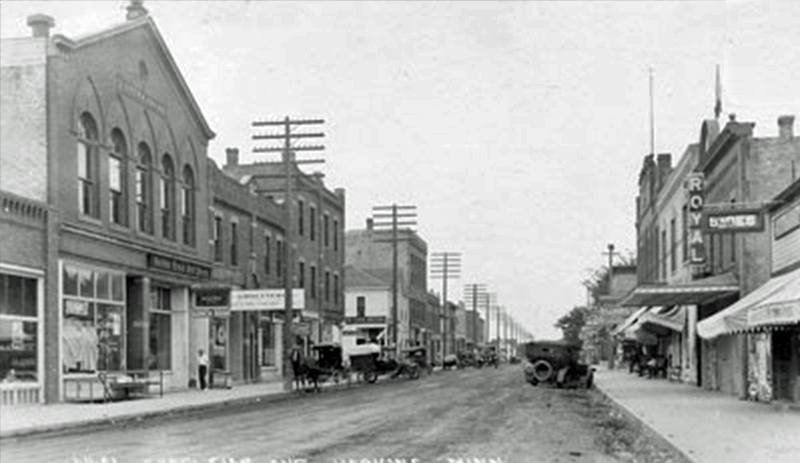
Hopkins Opera Hall on the far left – image from Hopkins Historical Society
STAG PARTY RAID!
On May 1, 1932, nearly 500 men, allegedly identified as the Minnesota Chauffeurs’ Club from Minneapolis, attended a stag party at Olson’s Hall, paying $1 each to enjoy five girl dancers doing “a series of butterfly dances, difficult to describe in mere words.” Unfortunately, a dozen deputies rose in their seats and announced the place was raided. Someone turned out the lights and there was a mad dash for the door; two of the deputies were injured in the melee. The girls were jailed, plead guilty, and were ordered to pay $50 or spend 60 days in the county jail on charges of indecent exposure. Four men were charged as alleged producers and drew similar sentences. (Minneapolis Star, May 5, 1932)
At trial, the questions and answers were a bit difficult to answer:
“What were the girls wearing?” Justice Meeker asked Deputy Oscar Thompson.
“Well,” gulped Thompson, “they seemed to have on shoes and stockings.
“What else?”
“Something gossamer that shed in layers.”
“Was it artistic?”
“I’ll tell the world it was.”
October 1937: Hopkins Variety Store (814)
September 1947 – 1961: Hopkins Alleys (816)
April 1951: C.J. Sommers Variety Store (814)
May 1955: Swanels Surprise Shop (814)
SHEEHAN’S 908 COCKTAIL LOUNGE
November 1955: Sheehan’s Bar (816)
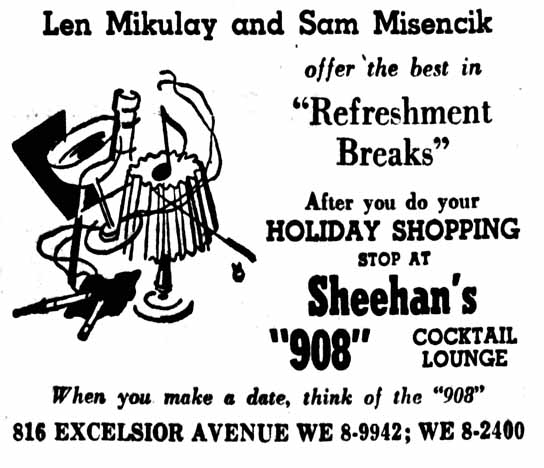
Minneapolis Star, November 15, 1956
In November 1958 there was a fire at Sheehan’s bar. The owners were identified as James, Thomas, and John Sheehan. The building held a bar, liquor store, and bowling alley, which had been there since at least 1947.
On December 14, 1959, a dram shop lawsuit identified the owner of Sheehan’s as Lee G. Zrust.
After these troubles, Sheehan’s apparently became just The 908 Bar, described as a workingman’s bar with no entertainment.
THE BULL PEN
In about February 1959, the Bull Pen took up residence in the 814 side of the building. It was opened by Harry Blons as a venue for his jazz band.
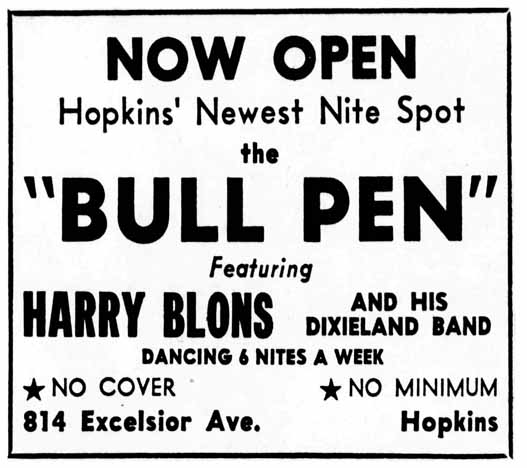
Minneapolis Star, February 26, 1959
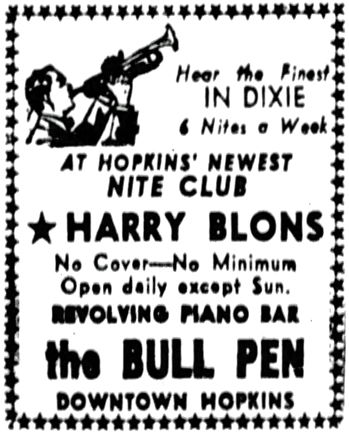
July 4, 1959
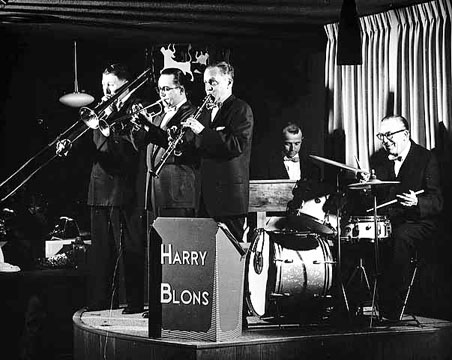
Undated photo of Harry Blons at the Bull Pen from Minnesota Historical Society
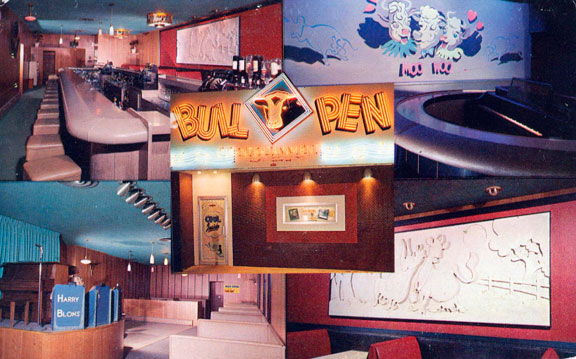
The Bull Pen hosted other types of music as well, including jazz and country.
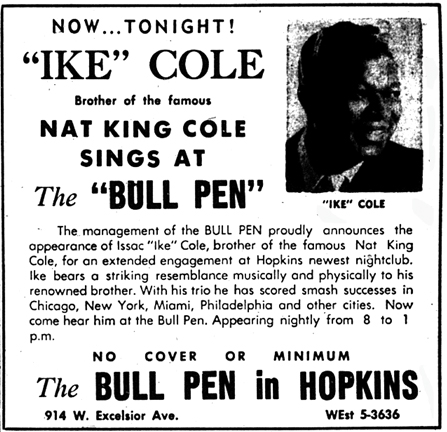
September 1, 1960
In 1961 the building was purchased by Virgil Miller, Dick Strachota, and Don Nickodym.
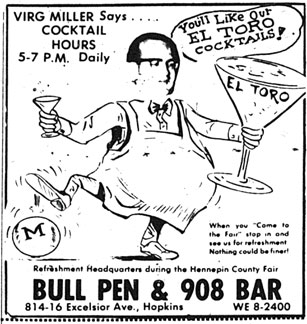
August 1962
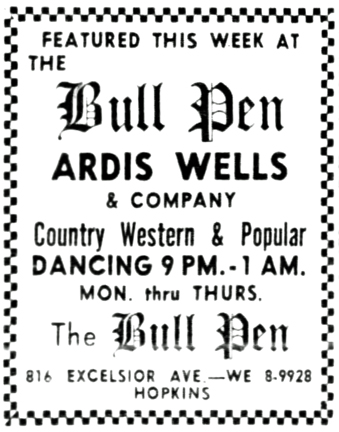
January 19, 1963
1963-64: Big Daddy and the Misfits played there for at least a year.
BULL PEN A GO-GO
In 1967, the Bull Pen took a turn toward loud music and G0-G0 dancing, even though the Go-Go fad was kind of a 1965 phenomenon. But the Bull Pen took it further, providing 15 years of nude dancing – the only bar in town to do so.
It appeared to start innocently enough. In one of his typically hilarious columns, Jim Klobuchar focused mostly on the noise generated at the bar, going so far as to bring a decibel meter to compare the cacophony to other known noise nuisances. He was blown away:
You may have heard noise in your life but you have never been so completely blasted, stretched, and flattened until you have spent a couple of hours in the Bull Pen Bar on a Friday night.
That was just the band. The Go-Go dancer was a “spectacular blonde named Cheri Rexroth, thrashing a go-go on a tiny platform.” Cheri was born in the Twin Cities, learned her craft in Chicago, returned with her “acrobatic culture. Tonight she is wearing tangerine tights and frequent expressions of anguish.”
Virg Miller explained that “We could advertise more, but we’d bring in the riffraff. We like to have them come reasonably well dressed and so we try to keep out the hairy-chested, open-shirt characters…”
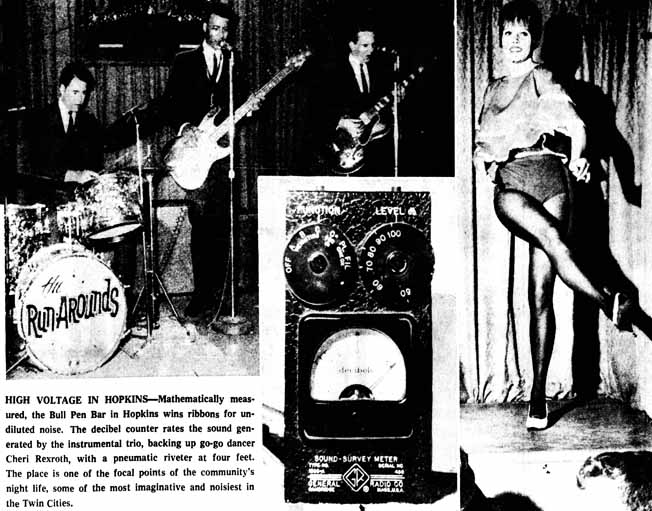
Minneapolis Star, June 19, 1967
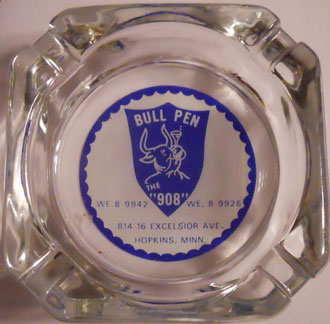
From the collection of Mark Youngblood
A 1968 ad from the Minnetonka Sun said the Bull Pen was owned by Virgil Miller, the band was the Professionals, and “Sheri” provided the “very best in GO GO.”
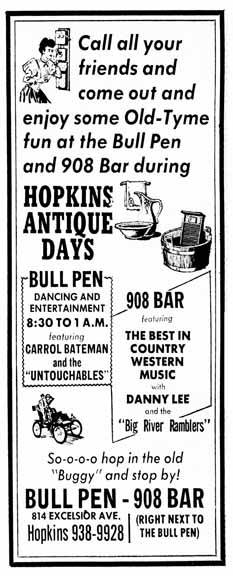
Minneapolis Star, April 4, 1968
Eventually the go-go dancing drifted to nude dancing, and stayed that way until 1982.
OPERA HALL SALOON
The Bull Pen had to go. After 15 years of nude dancing, in 1981 Hopkins enacted an ordinance that outlawed such activity in bars. The ordinance was based on a St. Paul ordinance – Hopkins just scratched out the name St. Paul and substituted Hopkins. The Chief of Police couldn’t see the dancing go fast enough, noting that most of the customers were men, most were not from Hopkins, and they were more rowdy and boisterous” than those at other bars. In February 1980, a customer shot a bouncer through the neck.
In February 1982, the owners closed the bar and began a renovation that would cost them about$258,000. $78,000 of that amount came from a low-interest loan provided by the City to fix up Mainstreet buildings.
Work included removing coverings from floors, ceilings and walls, exposing the old tin ceilings and brick walls. Arches were cut into the brick inner wall, connecting the Bull Pen and the 908 Bar. The 908 Bar stayed open for all but one month of the six-month construction period. The dance floor and bandstand were on the Bull Pen side.
The Grand Opening of what was called the Opera Hall Saloon was August 10 through 15, 1982. The music changed to Country, Country Rock, and ’50s.
MAINSTREET BAR AND GRILL
This new business first advertised for staff in October 1988. It is still there!
